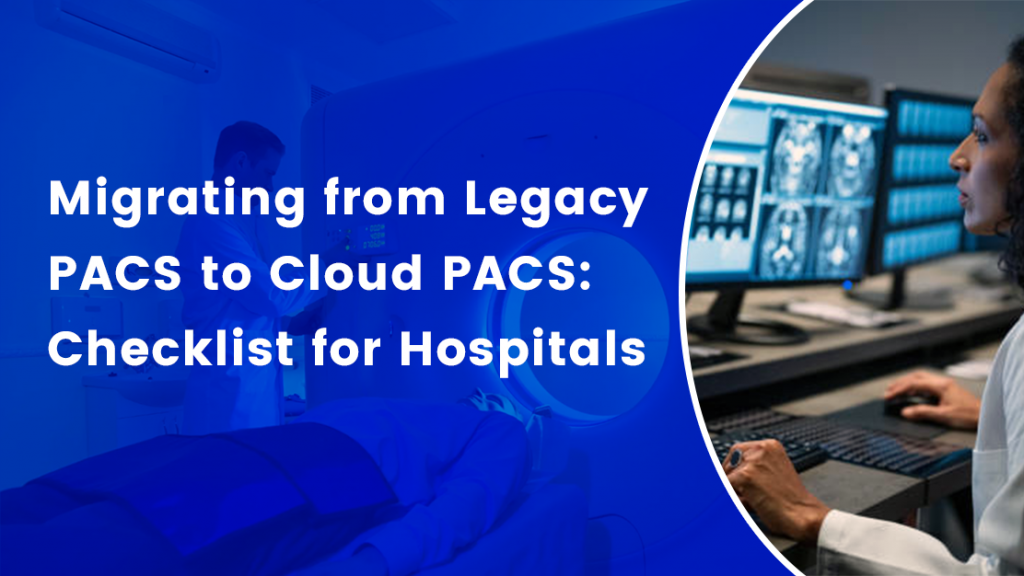For decades, the on-premise PACS (Picture Archiving and Communication System) was a cornerstone of radiology departments. These legacy systems successfully digitized medical imaging, but they came with significant limitations: high maintenance costs, limited scalability, and accessibility issues. In an era defined by telehealth, remote work, and data-driven healthcare, these drawbacks are no longer sustainable.
Hospitals are now strategically shifting to Cloud PACS, a modern solution that promises enhanced efficiency, security, and flexibility. However, migrating from a legacy system to the cloud is a complex undertaking. It requires meticulous planning to ensure a smooth transition with no disruption to patient care. This checklist provides a comprehensive guide for hospitals to successfully navigate their PACS migration.
Phase 1: Pre-Migration Planning and Assessment
A successful migration begins long before any data is moved. This phase is about preparation, collaboration, and setting a clear roadmap.
- Form a Dedicated Migration Team: Assemble a cross-functional team including key stakeholders from IT, radiology, administration, and finance. Appoint a project manager to oversee the entire process.
- Conduct a Thorough System Audit:
- Legacy PACS Health Check: Assess the current system’s performance, stability, and existing pain points. Document all hardware and software components.
- Data Audit: Determine the total volume of historical data to be migrated. Identify all data sources
- Workflow Analysis: Map out existing radiology workflows to understand how the new system will need to be integrated. Identify areas for improvement.
- Define Your Cloud PACS Requirements: Based on your assessment, create a list of essential features.
- Vendor-Neutral Archive (VNA): A VNA is crucial to prevent vendor lock-in. Ensure the new system stores data in a standardized, open format. o Interoperability: The new system must seamlessly integrate with your existing Hospital Information System (HIS), Electronic Health Record (EHR), and Radiology Information System
- Data Audit: Determine the total volume of historical data to be migrated. Identify all data sources
- Workflow Analysis: Map out existing radiology workflows to understand how the new system will need to be integrated. Identify areas for improvement.
- Define Your Cloud PACS Requirements: Based on your assessment, create a list of essential features.
- Vendor-Neutral Archive (VNA): A VNA is crucial to prevent vendor lock-in. Ensure the new system stores data in a standardized, open format.
- Interoperability: The new system must seamlessly integrate with your existing Hospital Information System (HIS), Electronic Health Record (EHR), and Radiology Information System (RIS).
- Security and Compliance: Confirm the vendor is compliant with all relevant regulations (e.g., HIPAA) and has robust data encryption, access controls, and disaster recovery protocols.
Phase 2: Vendor Selection and Contractual Agreements
Choosing the right partner is arguably the most important step in the entire process.
- Shortlist and Vet Vendors: Research reputable Cloud PACS vendors. Request demos and technical specifications. Ask for references from hospitals of a similar size and scope.
Evaluate Total Cost of Ownership (TCO): Look beyond the initial price. Consider the long-term costs of a subscription model versus the on-premise costs of hardware, maintenance, and IT staff. Be aware of potential costs for data storage overages and additional services.
Scrutinize the Data Migration Plan: The vendor’s approach to data migration is a key differentiator. Ask detailed questions about their process:
- How will they handle the data transfer? Is it a single “big bang” migration or a phased approach?
- What are their data validation protocols to ensure near zero data loss or corruption?
- What is their plan for downtime and rollback in case of an issue?
Phase 3: Implementation and Data Migration
This is where the plan comes to life. A phased approach is highly recommended to minimize disruptions.
Establish a Hybrid Environment: Begin by setting up a hybrid system where new studies are sent to the Cloud PACS while the legacy system remains active for historical data. This allows staff to become familiar with the new platform without disrupting current operations.
- Migrate Historical Data: This is the most complex part of the process. Work with your vendor to:
- Prioritize Migration: Start with the most recent and frequently accessed studies, leaving older, less-critical archives for later.
- Validate Data Integrity: Implement a rigorous validation process to ensure that all DICOM tags and image integrity are maintained during the transfer.
- Clean Up Old Data: Use this opportunity to purge obsolete or duplicate studies, reducing the volume of data you need to migrate.
- Conduct Integration Testing:Before going live, conduct extensive testing of the new PACS with your EHR, RIS, and imaging modalities. Verify that patient information, orders, and reports are flowing correctly between all systems.
Phase 4: Training, Go-Live, and Post-Migration
The technical migration is only half the battle. User adoption is critical for success.
- Comprehensive Staff Training: Provide role-specific training for all users—radiologists, technologists, and administrative staff. Use a mix of in-person workshops, webinars, and online tutorials.
- Plan the Go-Live: Schedule the official cutover during a period of low activity. Have a dedicated support team from both your hospital and the vendor on-site to address any immediate issues.
- Post-Migration Support: The work doesn’t end after go-live.
- Monitor System Performance: Continuously monitor the new system’s performance and address any bottlenecks.
- User Feedback: Establish a formal channel for users to provide feedback and suggestions.
- Ongoing Support: Confirm the vendor’s commitment to continuous support, software updates, and security patches.
Conclusion:-
Migrating from a legacy PACS to a modern Cloud PACS is a transformative journey that can future-proof a hospital’s imaging infrastructure. Nandico is fastest growing PACS in India with robust SOPs for migration from old PACS. By following this meticulous checklist, healthcare leaders can ensure a seamless transition, minimize risks, and unlock the significant benefits of cloud technology: improved accessibility, enhanced collaboration, and the ability to deliver faster, more efficient care to patients.
